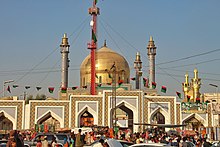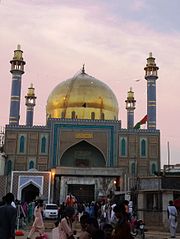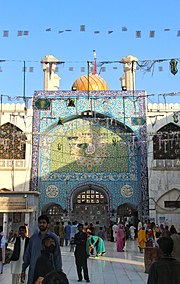Lal Shahbaz Qalandar
 From Wikipedia - Reading time: 10 min
From Wikipedia - Reading time: 10 min
Sayed Usman Marwandi Lal Shahbaz Qalandar | |
|---|---|
 | |
| Title | Qalandar |
| Personal | |
| Born | Sayed Usman Marwandi 1177[1] |
| Died | 19 February 1274 (aged 96–97)[1] |
| Religion | Islam |
| Parent | Sayyid Ibrahim Kabiruddin al-Jawabi (father)[3] |
| Other names | Lal Shahbaz Qalandar |
| Muslim leader | |
| Based in | Sehwan |
| Period in office | 12th/13th century |
Usman Marwandi, (1177 - 19 February 1274) popularly known as Lal Shahbaz Qalandar (Sindhi: لعل شهباز قلندر), was a Sufi saint and poet who is revered in South Asia.[1]
Born in Marwand, Sistan,[4][5] Lal Shahbaz Qalandar eventually settled in Sindh and is revered by the local Sindhi population.[6]
Names
[edit]
He is called Lal ("ruby-coloured") because he used to wear red color attire, red was his favorite color;[7] "Shahbaz" to denote a noble and divine spirit and "Qalandar" as he was a wandering spiritual man.[1]
Lal Shahbaz Qalandar is sometimes called Jhulelal (Sindhi: جھولےلال).[8][1] The term Jhulelal means "red bridegroom". There are various legends why he was called thus. According to the Garland Encyclopedia, Lal Shahbaz Qalandar was referred to as Jhulelal (red bridegroom) because he was promised marriage to a daughter of his friend, but the friend died and later his friend's son refused to allow the agreed upon marriage, which caused Lal Shahbaz Qalandar to grief.[9][10]
Life
[edit]Lal Shahbaz Qalandar, son of Sayyid Ibrahim Kabiruddin al-Jawabi,[11][3] was born in Marwand to a Sayyid family from Baghdad, Iraq. He later settled in Sehwan, Sindh under the reign of the Ghaznavid and Ghurids (today's Punjab, Pakistan).[12]
A contemporary of Rumi, he travelled around the Muslim world and settled in Sehwan, Sindh where he was eventually buried.[13] There is evidence of his presence in Sindh in 1196 when he met Pir Haji Ismail Panhwar of Paat and he is believed to have arrived in Sehwan around 1251. There he established a meeting house (khanqah), taught in the Fuqhai Islam Madarrsah and wrote his treatises Mizan-us-Surf, Kism-e-Doyum, Aqd and Zubdah. Lal Shahbaz lived a celibate life.[1]
In Multan, he met Baha-ud-din Zakariya of the Suhrawardiyya order, Baba Fariduddin Ganjshakar of the Chishtiyya and Syed Jalaluddin Bukhari. The friendship of these four became legendary. They were known as the Chahar Yar (In Persian "the four friends").[3] According to some historians, the four friends visited various parts of Sindh and Punjab (in present-day Pakistan).[3]
This was also the time period when Ghiyas ud din Balban (reigned: 1266 – 1287) ruled India.[3]
It is said Lal Shahbaz Qalandar was a tough ascetic. When he arrived in Sehwan (then Savistan), there was a shaivites cult of ascetics. He joined the ascetics, was engaged in tapasiya and acts of self-mortification like sitting on a cauldron of fire.[10]
The 19th century spiritual Sufi Manqabat Dama Dam Mast Qalandar is dedicated to Lal Shahbaz Qalandar and is widely popular in the sub-continent.
Shrine
[edit]

The shrine of Lal Shahbaz Qalandar was built by Feroz Shah Tughlaq in 1356,[14] expanded by Mirza Jani Beg[15] and his son Mirza Ghazi Beg of the Tarkhan dynasty, but was not completed until 1639, when Nawab Dindar Khan paved the courtyard with glazed tiles.[16] The silver work on the gate, the balustrade around the tomb and the top of the dome was gifted by Mir Karam Ali Talpur of the Talpur dynasty.[16] Later on the shrine was decorated with Sindhi 'kashi-tiles', mirror-work and a gold-plated door was installed by the late Prime Minister of Pakistan, Zulfikar Ali Bhutto.[17] The inner sanctum is about 100 square yards with a silver-canopied grave in the middle, according to Nadeem Wagan, Cutharo silver donated by Sardar Mahboob Ali Khan Wagan (Chief Sardar of Wagan Tribe) on one side of the marble floor is a row of about 12-inch-high (300 mm) folding wooden stands, on which there is a set of copies of the Quran for devotees to read. On the other side, beside a bundle of incense, are rows of oil-lamps lighted by devotees. Thousands of devotees visit the tomb particularly every Thursday.[18][19] The shrine is considered being the chief shrine for malangs and qalandars - adherents of a distinct Sufi order inspired by the teachings of Lal Shahbaz Qalandar.
Mela / Urs (Annual Fair)
[edit]Lal Shahbaz's annual Urs (death anniversary), held on the 18 Sha'aban – the eighth month of the Muslim lunar calendar, brings more than two million pilgrims from all over Pakistan and parts of India, Bangladesh. Essentially, it is a south Asian affair.[20]
The 2017 terrorist attack
[edit]On 16 February 2017, a group claimed responsibility for a suicide attack on the shrine, which resulted in the deaths of 88 people.[19] The following morning, the shrine's caretaker continued the daily tradition of ringing the shrine's bell at 3:30 A.M. and defiantly vowed that he would not be intimidated by the terrorists. Pakistani government and security forces have also launched a nationwide security crackdown and have recently killed 37 terrorists.[21] The shrine's dhamaal, or meditative dancing ceremony, was resumed the very next evening following the attack.[18]
Dhammal
[edit]Dhamaal is a mystical dance of Sindh which is mainly performed by faqirs, dervishs, sufi saints and devotees. The Dhammal of Hazrat Lal Shahbaz Qalandar is quite famous. The main performers would wear all red color Jama and Sindhi Patko (turban), the red is the color of Lal Shahbaz Qalandar, which was the favorite color of him, he wore the attire of red color as well, hence the name "Lal" has been given to him which means "Red".[22] Dhammal is characterized by religious fervor. Nagaro, Nobat, Gharyal, Ghugoo instruments etc provide the beat and tempo for the dance.
See also
[edit]References
[edit]- ^ a b c d e f "The Sufi in red Pakistan Today". archive.pakistantoday.com.pk. Retrieved 11 August 2021.
- ^ Jestice, Phyllis G. (2004). Holy People of the World: A Cross-cultural Encyclopedia, Volume 3. p. 493. ISBN 1576073556.
- ^ a b c d e Lohar, Masood (5 October 2004). "Saint revered by people of all religions". DAWN (newspaper). Retrieved 14 February 2018.
- ^ "Hazrat Lal Shehbaz Qalandar". Aal-e-Qutub Aal-e-Syed Abdullah Shah Ghazi. 18 December 2017. Retrieved 31 March 2023.
- ^ al-Karbassi, Dr. Shaykh Mohammed Sadiq (1 February 2014). Tarikh al-Sidana al-Husayniya (in Arabic). London, UK: Hussaini Charitable Trust. p. 55. ISBN 978-1-908286-99-4.
- ^ Sells, Michael (1 January 1995). Early Islamic Mysticism: Sufi, Qur'an, Mi'raj, Poetic and Theological Writings (1 ed.). Paulist Press. ISBN 0809136198.
- ^ admin (1 January 2012). "Story Of Pakistan | Lal Shahbaz Qalandar". Story Of Pakistan. Retrieved 4 April 2024.
- ^ Kugle, Scott (5 March 2007). Sufis and Saints' Bodies: Mysticism, Corporeality, and Sacred Power in Islam. The University of North Carolina Press. ISBN 978-0807857892.
- ^ The Garland Encyclopedia of World Music: South Asia : the Indian subcontinent, Garland Publishing, 1998, p. 760, ISBN 9780824049461
- ^ a b Dalrymple, William (7 June 2010). Nine Lives: In Search of the Sacred in Modern India. A&C Black. ISBN 978-1-4088-0124-6.
- ^ Qazi Ghulam Shabbir. Aqwal al-Masomin Fi Rad al-Muqasirin (in Urdu). Vol. 1. Pakistan. p. 57.
- ^ N B G Qazi (1971) Lal Shahbaz Qalandar Usman Marwandi. RCD Cultural Institute.
- ^ M Inam (1978) Hazrat Lal Shahbaz Qalandar of Sehwan Sharif. Karachi.
- ^ Hasan, Masudul (1965). Hand Book of Important Places in West Pakistan. Lahore: Pakistan Social Service Foundation. p. 21.
- ^ Balfour, Edward (1885). The Cyclopædia of India and of Eastern and Southern Asia, Volume 3. B. Quaritch. p. 562.
- ^ a b Journal of the Asiatic Society of Bengal, Volume 68. Asia: Bishop's College Press. 1899. p. 32.
- ^ Khan, Mohammad Hussain (11 March 2023). "In pictures: Devotees converge on Sehwan as Lal Shahbaz Qalandar's urs begins". DAWN.COM. Retrieved 18 April 2023.
- ^ a b "Pakistan's Sufis defiant after Islamic State attack on shrine kills 83". Reuters News Agency. 17 February 2017. Retrieved 14 February 2018.
- ^ a b "Sehwan bombing toll reaches 88, over 250 injured". The News International (newspaper). 17 February 2017. Retrieved 14 February 2018.
- ^ "In all its glory, Qalandar's urs culminates in Sehwan". The Express Tribune (newspaper). 18 May 2017. Retrieved 14 February 2018.
- ^ "37 terrorists killed in security crackdown after Sehwan bombing". The News International (newspaper). 17 February 2017. Retrieved 14 February 2018.
- ^ admin (1 January 2012). "Story Of Pakistan | Lal Shahbaz Qalandar". Story Of Pakistan. Retrieved 4 April 2024.
 KSF
KSF